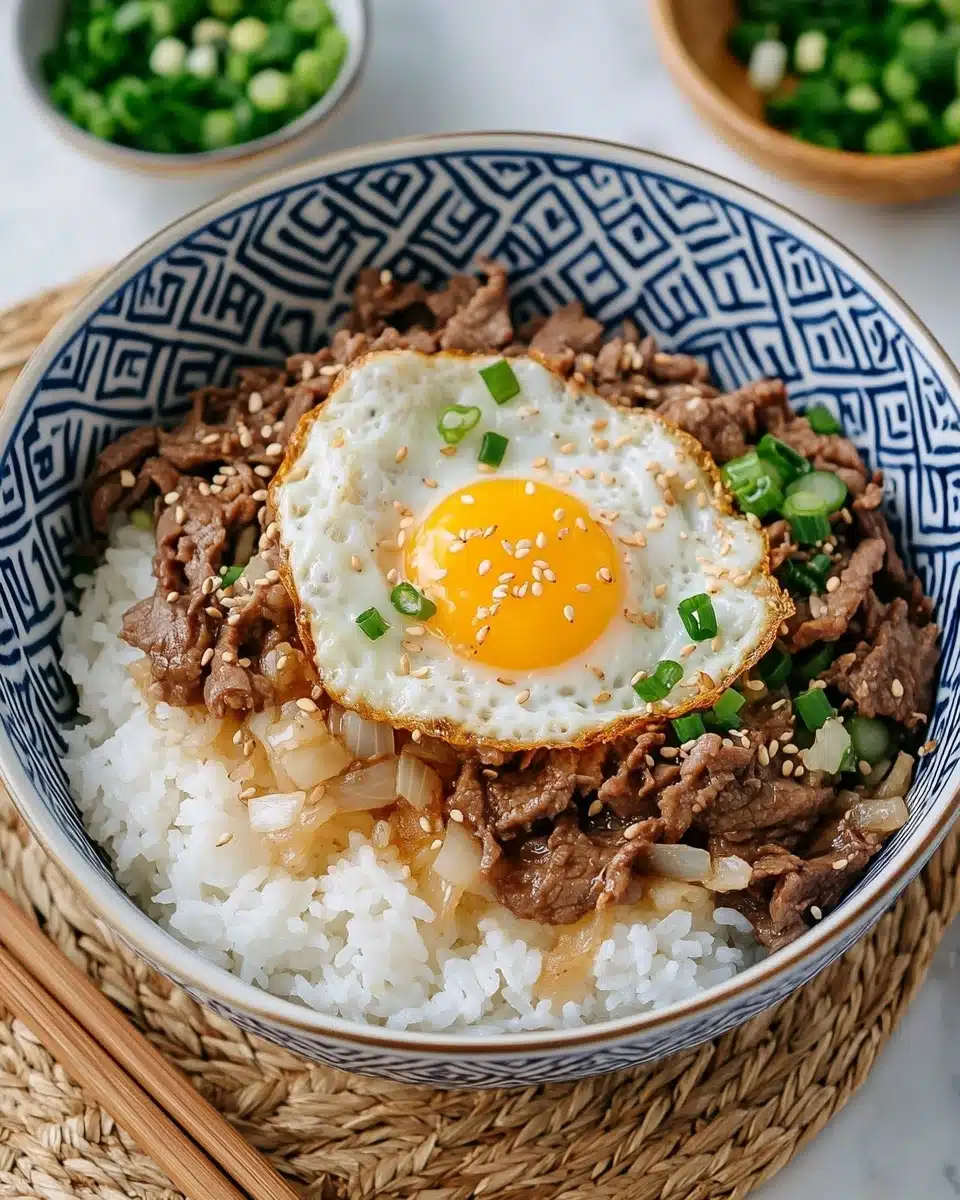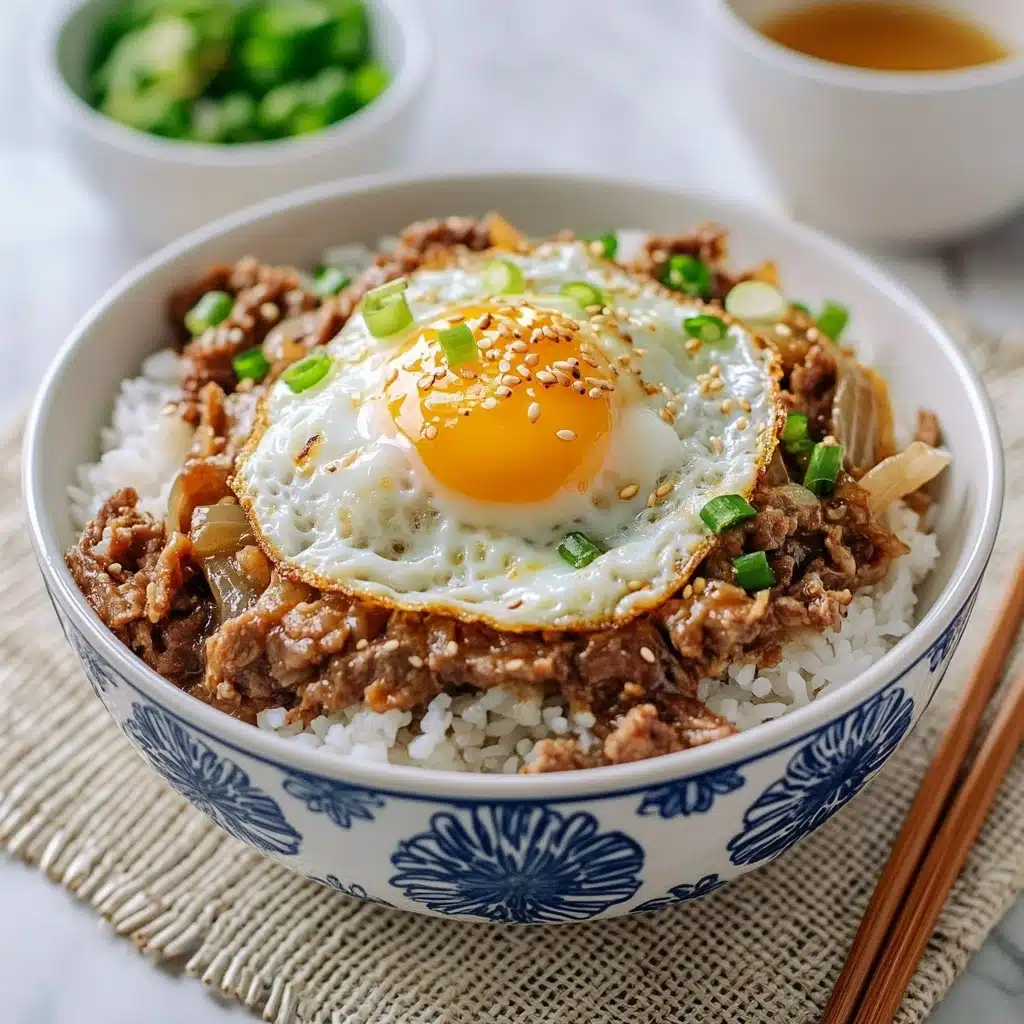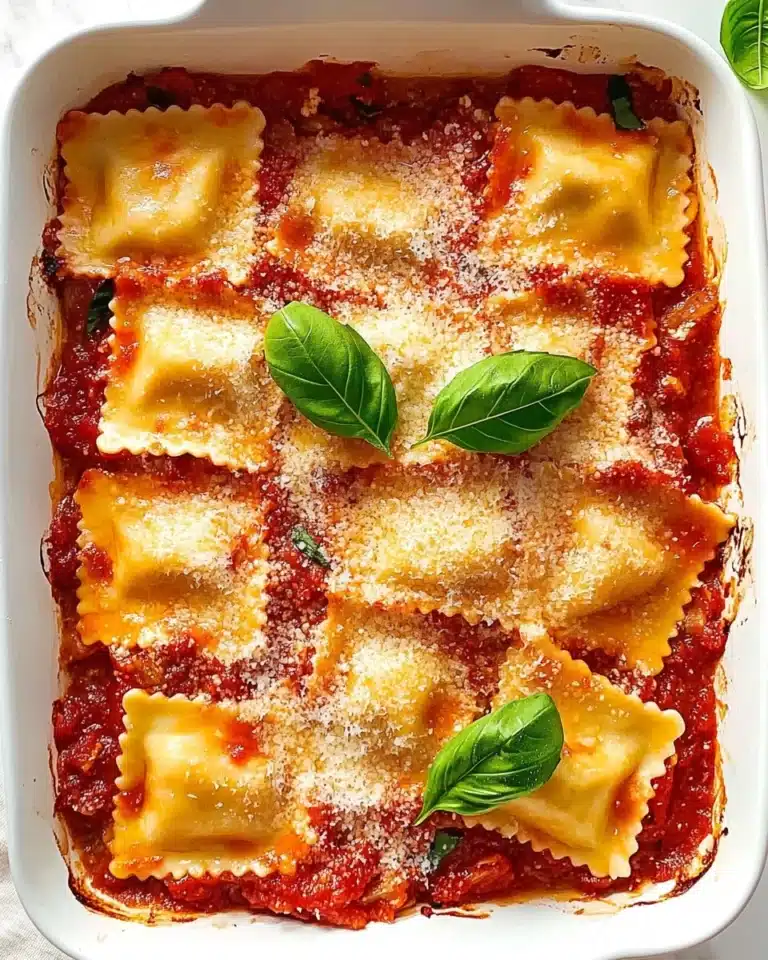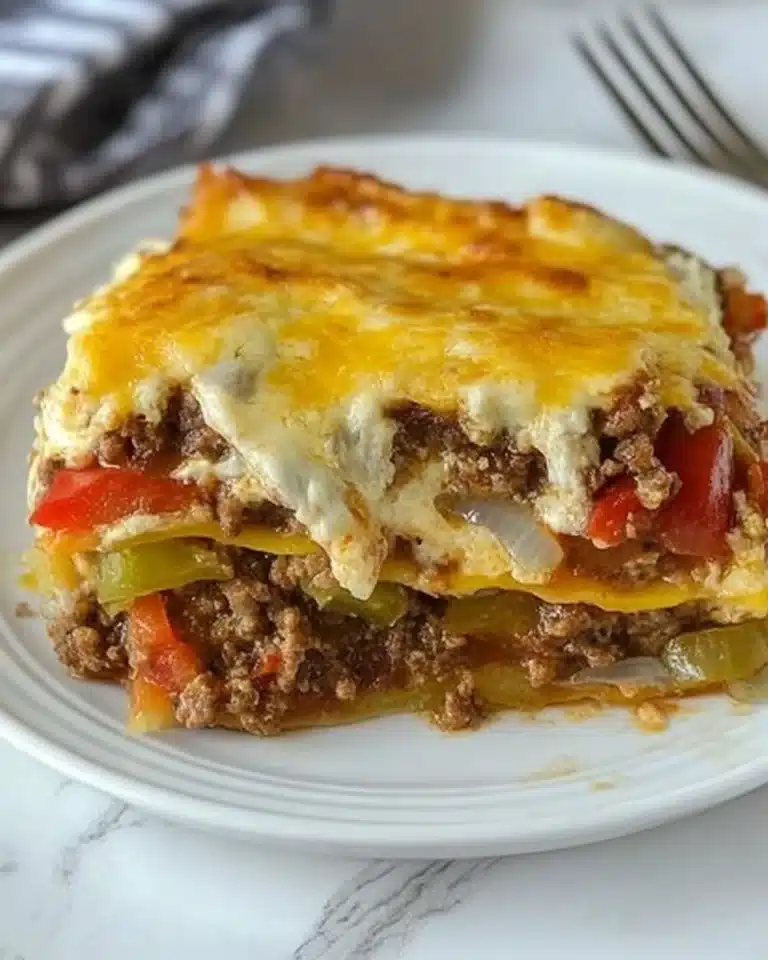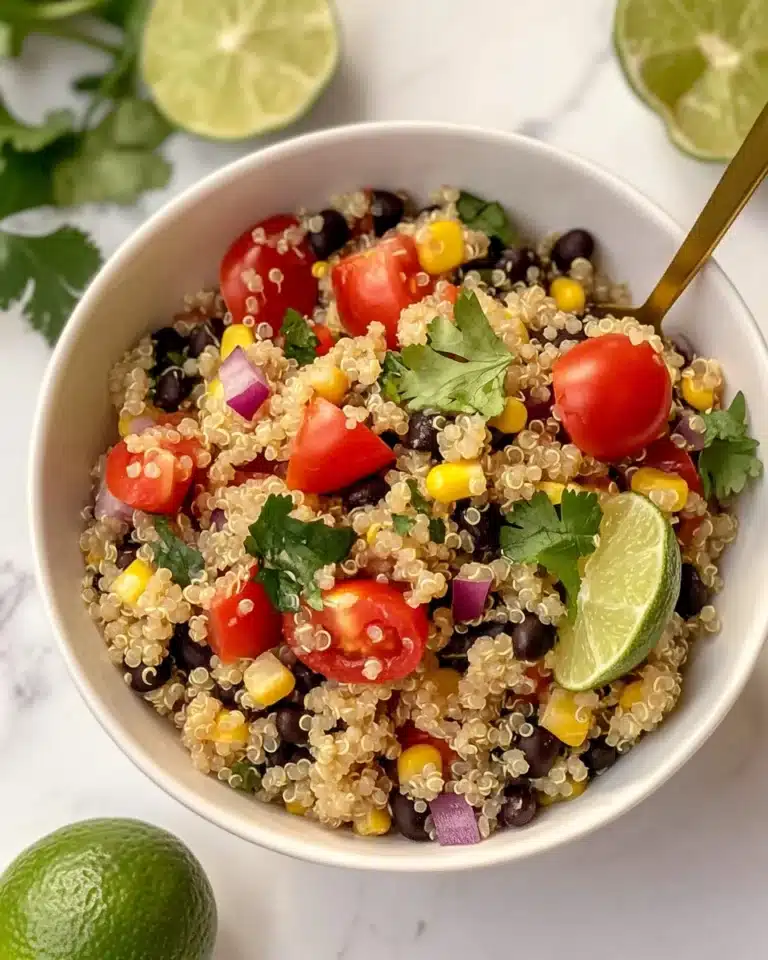If you’ve ever wandered into a cozy Japanese spot and tried Gyudon (Japanese Beef & Rice Bowls), you know how comfort food can get elevated with just a few simple ingredients. I absolutely love this recipe because it’s quick, satisfying, and has that perfect balance of sweet and savory glazed beef that wraps itself around fluffy rice. Whether it’s a busy weeknight or a weekend craving, Gyudon hits all the right notes without any fuss.
When I first tried making Gyudon at home, I was surprised by how approachable the ingredients are and how straightforward the method is—plus, you get to enjoy a mouthwatering bowl packed with flavor in under 40 minutes. This Gyudon (Japanese Beef & Rice Bowls) recipe has become a staple in my kitchen, and I’m excited to walk you through it so you can get these tender, oniony, beefy bowls on your table with ease.
Why You’ll Love This Recipe
- Simple Ingredients: You probably already have most of what you need, and the flavors come together beautifully with minimal effort.
- Quick Meal: From start to table in about 40 minutes, perfect when you want something hearty without the hassle.
- Customizable Comfort: Whether you like runny eggs or more sauce, this recipe adjusts easily to your preferences.
- Crowd-Pleaser: My family goes crazy for it — it’s a guaranteed winner for weeknight dinners or casual get-togethers.
Ingredients You’ll Need
The magic behind Gyudon lies in using high-quality, simple ingredients that balance sweet, savory, and umami flavors beautifully. With just a few pantry staples and fresh components like onions and scallions, you’ll get that classic taste that makes Japanese beef bowls so addictive.
- Neutral oil: Vegetable or canola oil works great here because they won’t overpower the delicate flavors.
- Onions: Thinly sliced onions caramelize nicely and bring sweetness that complements the beef perfectly.
- Beef: Use very thinly sliced fatty beef chuck or ribeye for tenderness and rich flavor, just like at authentic Japanese restaurants.
- Sugar: A little sweetness helps balance the salty soy sauce and adds depth.
- Mirin: This sweet rice wine adds a lovely glaze and subtle tang, essential for that authentic Gyudon kick.
- Soy sauce: Brings salty umami and ties the whole dish together.
- Dashi stock: Traditionally used in Japanese cooking, but you can substitute chicken or beef stock—you’ll still get that savory boost.
- Eggs: Sunny-side up eggs are my favorite topping because the runny yolk mixes into the rice making every bite silky.
- White rice: Short or medium grain rice holds the sauce well — think sticky and fluffy, perfect for soaking up all those flavors.
- Scallion: Finely chopped for a fresh, mild crunch on top.
- Toasted sesame seeds (optional): Adds a nice nutty crunch and a bit of extra flair.
Variations
I love customizing my Gyudon (Japanese Beef & Rice Bowls) recipe depending on what’s in season or what I’m in the mood for. This dish is super forgiving, so don’t be afraid to tweak it to your taste!
- Vegetarian Option: Swap the beef for thinly sliced mushrooms like shiitake or oyster mushrooms and use vegetable stock instead of dashi for a meat-free twist.
- Spicy Gyudon: Add a dash of chili oil or sprinkle red pepper flakes into the sauce for a subtle kick — my spicy-loving friends rave about this!
- Extra Veggies: Throw in some blanched spinach, shredded carrots, or even steamed broccoli for added texture and nutrition.
- Rice Alternatives: You can serve this over cauliflower rice or brown rice for a healthier or gluten-free variation.
How to Make Gyudon (Japanese Beef & Rice Bowls) Recipe
Step 1: Slowly caramelize the onions
Start by heating a couple of tablespoons of neutral oil in a large skillet over medium-high heat. Add the very thinly sliced onions and let them cook gently for about 10 minutes, stirring often. This slow cooking draws out their natural sweetness, which is key to balancing the savory beef. Keep an eye on them so they soften and develop a golden hue but don’t burn — patience here really pays off in flavor.
Step 2: Brown the beef and build the sauce
Add your thinly sliced beef and sugar to the skillet with the onions. Stir it all together and cook just until the beef starts to brown — you don’t want to overcook it or it’ll get tough. Now it’s time to add mirin, soy sauce, and dashi stock. Bring it all to a simmer, then reduce heat and let it gently bubble away for 10-15 minutes until the liquid thickens into a thin, glossy sauce that clings to the beef and onions.
Pro tip: Taste the sauce towards the end and adjust with a little more soy sauce if you want a deeper umami punch — this is where you make it your own!
Step 3: Prepare the perfect sunny-side-up eggs
While your beef simmers, heat a non-stick or cast iron skillet with a couple tablespoons of oil over medium heat. Cook the eggs sunny-side up until the whites are just set, but the yolks are still runny. This is one of my favorite parts — when you break those golden yolks over the beef and rice, it creates the creamiest texture you’ll ever want from a bowl of Gyudon.
If your pan is small, cook the eggs in batches—no rush!
Step 4: Assemble and garnish
Divide the warm steamed rice into four bowls. Spoon the delectable beef and onion mixture on top, making sure to get plenty of that flavorful sauce. Top each bowl with a perfectly cooked sunny-side-up egg. Finish by sprinkling chopped scallions and, if using, toasted sesame seeds for a bit of crunch and freshness.
Trust me, this simple assembly makes each bite a heartwarming spoonful of pure delight.
Pro Tips for Making Gyudon (Japanese Beef & Rice Bowls) Recipe
- Use Thinly Sliced Beef: I discovered this trick when I bought thin ribeye at an Asian market — it cooks in seconds and stays tender, making a huge difference in texture.
- Don’t Rush the Onions: Caramelizing onions slowly builds the dish’s signature sweetness and depth, so take your time and keep stirring!
- Balance the Flavor: Adjust soy sauce and sugar near the end of cooking to suit your taste — every batch is slightly different.
- Avoid Overcooking the Eggs: Make sure yolks stay runny; they melt into the rice and sauce, creating that creamy, luscious mouthfeel Gyudon is loved for.
How to Serve Gyudon (Japanese Beef & Rice Bowls) Recipe
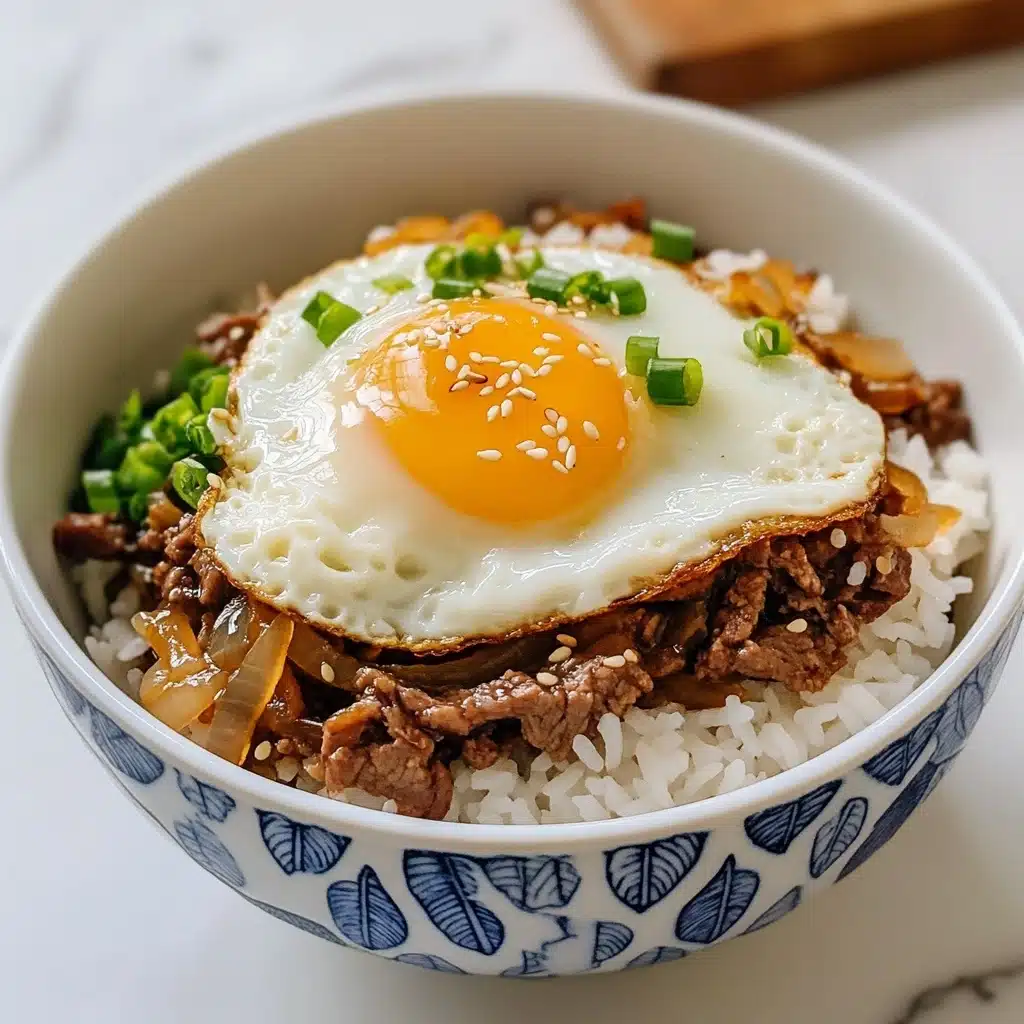
Garnishes
I always reach for chopped scallions because their fresh, peppery bite brightens the rich beef. Toasted sesame seeds are optional but add a lovely nuttiness and subtle crunch. Sometimes, I sprinkle a little shichimi togarashi (Japanese seven-spice) if I want a mild heat boost.
Side Dishes
My go-to sides for Gyudon are simple, like miso soup to keep with the Japanese comfort theme, or a quick cucumber sunomono salad for light acidity. Pickled ginger or kimchi are also great if you want a tangy or spicy kick that complements the rich beef.
Creative Ways to Present
For special occasions, I like to serve Gyudon in individual donburi bowls lined with a shiso leaf or nori strips. Drizzling a little extra mirin-soy reduction over the top right before serving adds a shiny, restaurant-quality finish. You can even make a layered bento-style box with Gyudon, steamed veggies, and pickles for a visually pleasing meal.
Make Ahead and Storage
Storing Leftovers
I store leftover Gyudon beef and onions in an airtight container in the fridge for up to 3 days. I keep the rice separate whenever possible to prevent it from soaking up all the sauce and getting mushy. This way, everything re-heats nicely.
Freezing
Freezing is doable but I prefer to freeze just the beef and onions without the eggs or rice, as those can change texture when thawed. When you’re ready, thaw overnight in the fridge and gently reheat on the stovetop.
Reheating
I warm leftover Gyudon gently in a skillet over low heat to avoid drying out the beef. If you have separate rice, microwaving it with a little water covered with a damp paper towel helps keep it fluffy. Add fresh eggs cooked sunny-side up to recreate the original experience.
FAQs
-
Can I use other cuts of beef for Gyudon?
Yes! While fatty beef chuck or ribeye thinly sliced works best for tenderness and flavor, you can also use sirloin or even flank steak sliced very thinly against the grain. The key is thin slices so the beef cooks quickly and stays tender.
-
Is dashi stock necessary, or can I skip it?
Dashi stock adds authentic umami flavor to Gyudon, but if you don’t have it, chicken or beef stock works fine as a substitution. You can even use water with a pinch of instant dashi powder if you want the closest flavor. The sauce will still taste delicious!
-
How do I get the eggs perfectly runny for Gyudon?
Cook eggs on medium heat in a non-stick skillet, making sure the whites set but the yolks remain runny. Cover the pan briefly if needed to help whites cook faster without flipping the eggs. The contrast between warm runny yolk and savory beef is what makes this dish so special.
Final Thoughts
Making Gyudon (Japanese Beef & Rice Bowls) Recipe at home has been such a rewarding experience for me — it’s fast, uses simple ingredients, and delivers big on flavor. It’s comfort food that feels special, perfect for sharing with family or impressing friends with minimal effort. I hope you find this recipe as enjoyable and approachable as I do, and that it becomes a go-to in your kitchen too. Don’t hesitate to tweak and make it your own — that’s part of the fun!
Print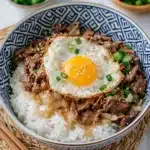
Gyudon (Japanese Beef & Rice Bowls) Recipe
- Prep Time: 10 minutes
- Cook Time: 30 minutes
- Total Time: 40 minutes
- Yield: 4 servings
- Category: Main Course
- Method: Stovetop
- Cuisine: Japanese
Description
Gyudon, a classic Japanese beef and rice bowl, features tender, thinly sliced beef simmered with onions in a savory and slightly sweet sauce. Topped with a sunny-side-up egg and garnished with scallions and toasted sesame seeds, this comforting dish comes together quickly on the stovetop for a delicious, satisfying meal perfect for any day.
Ingredients
Main Ingredients
- 2 teaspoons neutral oil (such as vegetable or canola oil)
- 2 medium onions, very thinly sliced
- 1 pound very thinly sliced beef (fatty beef chuck or ribeye)
- 2 teaspoons sugar
- 2 tablespoons mirin
- 2 tablespoons soy sauce
- 1 cup dashi stock (can substitute beef or chicken stock)
- 4 eggs
- 4 cups cooked white rice (short grain or medium grain preferred)
- 1 scallion, chopped
- 2 teaspoons toasted sesame seeds (optional)
Instructions
- Sauté Onions: Heat the neutral oil in a large skillet over medium-high heat. Add the thinly sliced onions and cook for about 10 minutes, stirring often until they are soft and slightly caramelized.
- Cook Beef: Add the thinly sliced beef and sugar to the skillet with onions. Cook until the beef is just slightly browned, stirring frequently to separate the slices.
- Simmer Sauce: Pour in the mirin, soy sauce, and dashi stock. Bring the mixture to a simmer, then let it cook for 10 to 15 minutes, allowing the liquid to reduce into a flavorful thin sauce. Taste and adjust seasoning with extra soy sauce if desired.
- Prepare Eggs: In a separate skillet, heat a couple tablespoons of oil over medium heat. Cook the eggs sunny-side up with runny yolks. If necessary, cook the eggs in batches to accommodate all four servings.
- Assemble Bowls: Divide the cooked white rice evenly into four bowls. Top each bowl with a generous portion of the simmered beef and onions, then place one sunny-side-up egg on top of each bowl.
- Garnish and Serve: Sprinkle chopped scallions and toasted sesame seeds over each serving if using. Serve immediately while warm for the best flavor and texture.
Notes
- Use very thinly sliced beef for the most authentic texture and quick cooking.
- Dashi stock adds traditional umami flavor, but beef or chicken stock can be used as alternatives.
- Cooking eggs sunny-side up with runny yolks adds richness and creaminess to the dish.
- Adjust soy sauce according to your salt preference.
- Short grain or medium grain rice is preferred for an authentic Japanese-style Gyudon experience.

